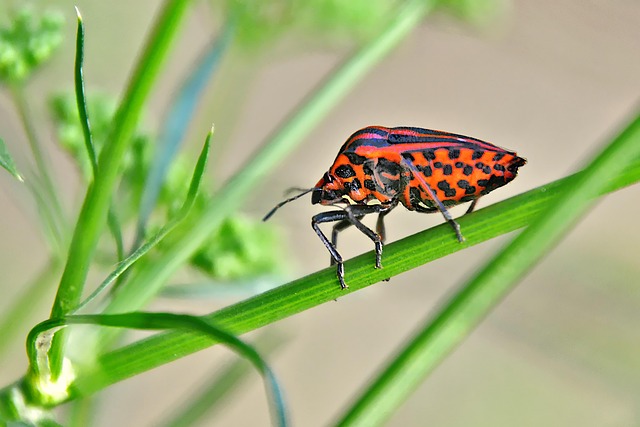Boxelder bugs (Boisea trivittatus) are Hemiptera that migrate indoors during cooler months, causing indoor air quality issues due to their life cycle products. Identified by their oval shape and red-brown color, they congregate in fall and winter, entering through cracks and gaps. Early assessment involves searching for live bugs, shed skins, and egg masses. Effective boxelder bug extermination strategies include chemical insecticides (selecting registered products), natural repellents, regular vacuuming, and sealing entry points to maintain indoor comfort and air quality.
“Uncovering the hidden threat: Exploring the Impact of Boxelder Bugs on Indoor Air Quality. These small yet persistent insects, scientifically known as Boisea trivittata, have become a growing concern for homeowners and professionals alike. With their unique behavior and habitat preferences, boxelder bugs can infiltrate living spaces, affecting air quality and causing discomfort. This comprehensive guide delves into their impact, offers insights on identification and infestation assessment, and provides effective strategies for successful boxelder bug extermination.”
Understanding Boxelder Bugs: Behavior and Habitat
Boxelder bugs, scientifically known as Boisea trivittatus, are small insects that belong to the stink bug family. They are named after their preferred hosts—boxelder trees (Acer negundo), but they can also infest other tree species and structures. These bugs are primarily outdoor inhabitants, living and breeding in forests, parks, and gardens. However, during the cooler months, they seek warmer indoor spaces, posing a common pest problem for homeowners.
Understanding their behavior is crucial when it comes to boxelder bug extermination. They enter buildings through cracks, gaps around windows, doors, and utility pipes. Once inside, they congregate in large numbers on sunny walls and ceilings, often moving collectively in a phenomenon known as “hatching.” This mass movement can be unsettling for residents and indicates a need for effective boxelder bug control measures to maintain indoor air quality and comfort.
How Boxelder Bugs Affect Indoor Air Quality
Boxelder bugs, despite their name, are not actual insects but a type of true bug belonging to the Hemiptera order. While they may seem harmless, these creatures can significantly impact indoor air quality when present in large numbers. When boxelder bugs infest homes or commercial spaces, they go through several life stages, leaving behind various byproducts that contribute to poor air quality.
During their development, boxelder bugs secrete sticky substances and excrete waste, both of which can become airborne. These substances contain allergens and irritants, such as protein particles and bacteria, that can trigger respiratory issues in sensitive individuals. Additionally, the debris from dead bugs and their shed skins can accumulate, leading to increased dust and allergen levels in the air. Efficient boxelder bug extermination is crucial for maintaining healthy indoor environments, ensuring air quality standards, and providing relief for those affected by these pesky intruders.
Identifying and Assessing Infestations
Identifying and assessing infestations of boxelder bugs is a critical first step for homeowners and property managers aiming to mitigate their impact on indoor air quality. These insects, with their distinctive oval shapes and red-brown coloration, often congregate in large numbers during the fall and winter months, seeking shelter from the cold. They can infiltrate homes through cracks, gaps, and vents, leading to visible swarms and unsightly debris around windowsills and doors.
Assessing the extent of an infestation involves inspecting affected areas for live bugs, shed skins, and egg masses. A thorough examination may reveal their presence in corners, behind furniture, and within walls, highlighting the need for professional boxelder bug extermination. Early detection is key to minimizing damage and preventing these pests from compromising indoor air quality by introducing allergens and exacerbating existing respiratory conditions.
Effective Extermination Strategies for Boxelder Bugs
When dealing with a boxelder bug infestation, effective extermination strategies are crucial for maintaining indoor air quality and preventing further damage. One popular method involves using insecticides specifically designed to target these pests. These chemicals can be applied in cracks, crevices, and around windowsills where boxelder bugs tend to hide. It’s important to select a product registered by regulatory bodies and follow the manufacturer’s instructions precisely to ensure safety and maximize effectiveness.
Alternative solutions for boxelder bug extermination include natural repellents and mechanical controls. Essential oils like citrus, peppermint, or neem oil can act as natural deterrents. Regular vacuuming, especially during the bugs’ active seasons, helps remove adult bugs, eggs, and larvae from floors and surfaces. Additionally, sealing entry points and repairing any gaps in doors or windows can prevent reinfestation, making your space less appealing for these intruders.
Boxelder bugs can significantly impact indoor air quality, causing discomfort and potential health issues. Understanding their behavior and habitat is crucial for effective prevention and control. By identifying infestations early and employing suitable extermination strategies, such as professional boxelder bug extermination services, homeowners can ensure a comfortable and healthy living environment. Regular inspections and prompt action are key to minimizing these pests’ negative effects on air quality.
